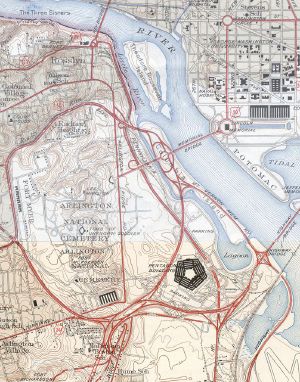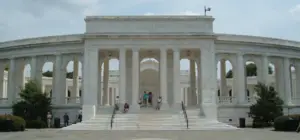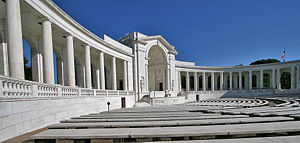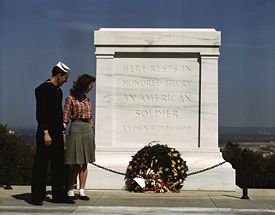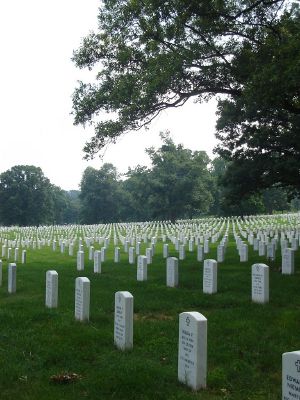Difference between revisions of "Arlington National Cemetery" - New World Encyclopedia
Mary Anglin (talk | contribs) |
Mary Anglin (talk | contribs) |
||
| Line 212: | Line 212: | ||
[[Category:Historical Sites]] | [[Category:Historical Sites]] | ||
[[Category:Military]] | [[Category:Military]] | ||
| − | {{credit|263703583}} | + | {{credit|Arlington_National_Cemetery|263703583|Arlington_Memorial_Amphitheater|253151374}} |
Revision as of 23:13, 15 January 2009
| Arlington National Cemetery | |
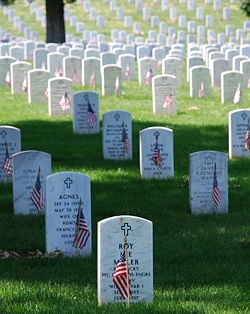 The gravestones at Arlington National Cemetery are graced by U.S. flags each Memorial Day. | |
| Cemetery Details | |
|---|---|
| Year established: | June 15, 1864 |
| Country: | United States |
| Location: | Arlington, Virginia |
| Coordinates: | Coordinates: |
| Type: | Public |
| Owned by: | United States Department of Veterans Affairs |
| Size: | 624 acres (3 km²)) |
| Number of gravesites: | 245,000+ |
| Website: | Official Site |
| Find A Grave: | Findagrave |
Arlington National Cemetery, in Arlington, Virginia, is a military cemetery in the United States, established during the American Civil War on the grounds of Arlington House, formerly the estate of the family of Robert E. Lee's wife Mary Anna (Custis) Lee, a descendant of Martha Washington. The cemetery is situated directly across the Potomac River from Washington, D.C., near The Pentagon, and is served by the Arlington Cemetery station on the Blue Line of the Washington Metro system.
More than 290,000 people are buried in an area of 624 acres (2.53 km²). Veterans and military casualties from every one of the nation's wars are interred in the cemetery, from the American Revolution through the military actions in Afghanistan and Iraq. Pre-Civil War dead were reinterred after 1900.
Arlington shares with Mill Springs National Cemetery, the only other open cemetery in the system, the distinction of being the oldest military burial ground in the United States.
First soldier to be buried in Arlington was William Henry Christman on May 13, 1864. American military cemeteries developed from the duty of commanders on the frontier and in battle to care for their casualties. Arlington National Cemetery and United States Soldiers' and Airmen's Home National Cemetery are administered by the Department of the Army. The other National Cemeteries are administered by the Department of Veterans Affairs or by the National Park Service.
Arlington House (Custis-Lee Mansion) and its grounds are administered by the National Park Service as a memorial to Lee.
History
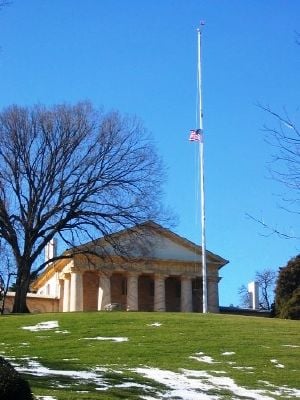
Arlington House is a 19th-century mansion standing amid the more than 250,000 military gravesites that stretch out around it. When construction began on the mansion it was intended as a living memorial to George Washington, the nation's first president. It was built by Washington's adopted grandson, George Washington Parke Custis. Custis hired George Hadfield, an English architect who came to Washington in 1785 to help construct the U.S. Capitol, to design his estate. The Greek revival structure which Hadfield designed took Custis 16 years to complete. The north wing was the first structure completed in 1802, the south wing in 1804. In 1818 the central section was completed, which connected the various wings. The exterior portico contains eight columns, each five feet in diameter at the base.
George Washington Parke Custis and his wife, Mary Lee Fitzhugh, lived in Arlington House for the rest of their lives and were buried together on the property after their deaths in 1857 and 1853, respectively. Their only child, Mary Anna Randolph Custis, married her childhood friend and distant cousin, Robert E. Lee, a graduate of the United States Military Academy at West Point. Lee and his wife lived at Arlington House until 1861.
Before the Civil War, Robert E. Lee had been a United States Army officer. When Fort Sumter was forced to surrender, President Abraham Lincoln offered Lee the command of the Federal army. Lee demurred, because he wanted to see how Virginia would decide.
Virginia ratified an alliance with the Confederacy and seceded from the Union. When Virginia announced its secession, Lee resigned his commission and took command of the armed forces of the state of Virginia, and later became commander of the Army of Northern Virginia.[1] He quickly established himself as an able commander, defeating a series of Union generals, until his final defeat and surrender at Appomattox Court House.
Following the ratification of Virginia's secession, federal troops crossed the Potomac and, under Brig. Gen. Irvin McDowell, took up positions around Arlington House. Following the occupation, military installations were erected at several locations around the 1,100-acre estate, including Fort Whipple (now Fort Myer) and Fort McPherson (now Section 11 of the cemetery).
The property was confiscated by the federal government when property taxes levied against Arlington estate were not paid in person by Mrs. Lee. The property was offered for public sale January 11, 1864, and was purchased by a tax commissioner for "government use, for war, military, charitable and educational purposes."
Arlington National Cemetery was established by Brig. Gen. Montgomery C. Meigs, who commanded the garrison at Arlington House, appropriated the grounds June 15, 1864, for use as a military cemetery. His intention was to render the house uninhabitable should the Lee family ever attempt to return. A stone and masonry burial vault in the rose garden, 20 feet wide and 10 feet deep, and containing the remains of 1,800 Bull Run casualties, was among the first monuments to Union dead erected under Meigs' orders. Meigs himself was later buried within 100 yards of Arlington House with his wife, father and son; the final statement to his original order.
Lee deeply regretted the loss of his home at Arlington and continued to feel responsible for the estate. He earnestly hoped that the slaves who were left behind would be educated and freed, according to the provisions of Custis' will. The federal government dedicated a model community for freed slaves, Freedman's Village, near the current Memorial Amphitheater, on December 4, 1863. More than 1,100 freed slaves were given land by the government, where they farmed and lived during and after the Civil War.
Neither Robert E. Lee, nor his wife, ever returned to Arlington House, nor did they ever attempted to publicly recover control of it. They were buried at Washington University (later renamed Washington and Lee University) where Lee had served as president. After Gen. Lee's death in 1870 his oldest son, Custis Lee, claimed that the land had been illegally confiscated and that, according to his grandfather's will, he was the legal owner. In December 1882, the U.S. Supreme Court, in a 5-4 decision, returned the property to Custis Lee, stating that it had been confiscated without due process.
On March 3, 1883, Congress purchased the property from Lee for $150,000. It became a military reservation, and Freedman's Village, but not the graves, was removed.
Features of the cemetery
Arlington Memorial Amphitheater
The Arlington Memorial Amphitheater, near the center of the Cemetery, is the home of the Tomb of the Unknowns. This site has also hosted the state funerals of many famous Americans, such as General of the Armies John J. "Black Jack" Pershing, General of the Air Force Henry H. "Hap" Arnold, the Unknown Soldiers, and five victims of the September 11 attacks, as well as annual Memorial Day and Veterans Day ceremonies. Every American President of the 20th and 21st centuries has presided over holiday gatherings at this site.
Judge Ivory Kimball worked during several sessions of Congress as the department head of the Grand Army of the Republic in the District to get a bill through Congress to build the Amphitheatre. The bill finally went through in President Theodore Roosevelt's administration, when Congress authorized its construction March 4, 1913. Judge Kimball participated in the ground-breaking ceremony, March 1, 1915, but did not live to see his dream completed. President Woodrow Wilson placed its cornerstone Oct. 15, 1915.
A colonnade of arched openings with attached Doric columns on the piers completely encloses the amphitheater. The architect was Thomas Hastings of the New York-based firm of Carrère and Hastings. The structure is mostly built of Imperial Danby marble from Vermont. The Memorial Display room, between the amphitheater and the Tomb of the Unknowns, uses Botticino stone, imported from Italy.
Before the Arlington Memorial Amphitheater was completed in 1921, important ceremonies were held at what is now known as the "Old Amphitheater." This structure sits where Robert E. Lee once had his gardens. The amphitheater was built in 1868 under the direction of General John A. Logan. Gen. James Garfield was the featured speaker at the Decoration Day dedication ceremony, May 30, 1868. The amphitheater has an encircling colonnade with a latticed roof that once supported a web of vines. The amphitheater has a marble dais, known as "the rostrum," which is inscribed with the U.S. national motto found on the Great Seal of the United States, E pluribus unum ("Out of many, one"). The amphitheater seats 1,500 people and has hosted speakers such as William Jennings Bryan.[2]
Tomb of the Unknowns
The Tomb of the Unknowns is a monument dedicated to American servicemen who have died without their remains being identified. The "Unknown Soldier" of World War I is a recipient of the Medal of Honor, the Victoria Cross, and several other foreign nations' highest service awards. The U.S. Unknown Soldiers who were interred afterwards are also recipients of the Medal of Honor, presented by the U.S. presidents who presided over their funerals.[3][4][5]
One of the more popular sites at the Cemetery, the tomb is made from Yule marble quarried in Colorado. It consists of seven pieces, with a total weight of 79 short tons (72 metric tons). The tomb was completed and opened to the public April 9, 1932, at a cost of $48,000.
It was initially named the "Tomb of the Unknown Soldier." Other unknown servicemen were later entombed there, and it became known as the "Tomb of the Unknowns," though it has never been officially named. The soldiers entombed there are:
- Unknown Soldier of World War I, interred November 11, 1921. President Warren G. Harding presided.
- Unknown Soldier of World War II, interred May 30, 1958. President Dwight D. Eisenhower presided.
- Unknown Soldier of the Korean War, also interred May 30, 1958. President Dwight Eisenhower presided again, Vice President Richard Nixon acted as next of kin.
- Unknown Soldier of the Vietnam War, interred May 28, 1984. President Ronald Reagan presided. The remains of the Vietnam Unknown were disinterred, under the authority of President Bill Clinton, on May 14, 1998, and were identified as those of Air Force 1st Lt. Michael J. Blassie, whose family had him reinterred near their home in St. Louis, Missouri. It has been determined that the crypt at the Tomb of the Unknowns that contained the remains of the Vietnam Unknown will remain empty.
The Tomb of the Unknowns is perpetually guarded by the U.S. Army. The 3rd U.S. Infantry Regiment ("The Old Guard") began guarding the Tomb April 6, 1948.
Other notable sites
Other frequently visited sites in the cemetery are the USMC War Memorial (commonly known as the "Iwo Jima Memorial") and the Netherlands Carillon (these sites are actually located adjacent to the cemetery), and the grave of President John F. Kennedy. Kennedy is buried with his wife and two of their children. He was placed here March 14, 1967. His grave is marked with an eternal flame. His brother, Senator Robert F. Kennedy, is also buried nearby. The latter's grave is marked by a simple cross.
The federal government dedicated a model community for freed slaves, Freedman's Village, near the current Memorial Amphitheater, December 4, 1863. More than 1,100 freed slaves were given land by the government, where they farmed and lived during and after the Civil War. They were turned out in 1890 when the estate was repurchased by the government and dedicated as a military installation.
In Section 27, there are buried more than 3,800 former slaves, called "Contrabands" during the Civil War. Their headstones are designated with the word "Civilian" or "Citizen."
Also, in the cemetery, there is a Confederate section with graves of soldiers of the Confederate States of America and a Confederate Memorial.[6]
Near the Tomb of the Unknowns stands a memorial to the 266 men who lost their lives aboard the USS Maine. The memorial is built around a mast salvaged from the Maine's wreckage.[7] (The Maine's other mast is erected at the United States Naval Academy, making the Maine the "longest ship in the Navy" in Naval Academy tradition.) The Maine Memorial has served as the temporary resting place for foreign heads of state allied with the United States who died in exile in the United States during the Second World War, pending the return of their remains to their homeland. These were Manuel L. Quezon of the Philippines and Ignacy Jan Paderewski of Poland.
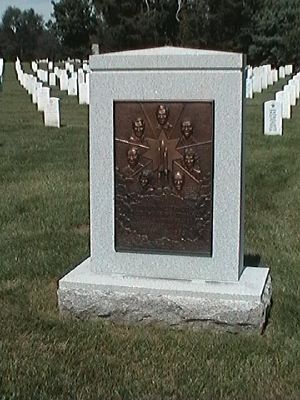
The Space Shuttle Challenger Memorial was dedicated on May 20, 1986 in memory of the crew of flight STS-51-L, who died during launch on January 28, 1986. Transcribed on the back of the stone is the text of the John Gillespie Magee, Jr. poem entitled High Flight. Although many remains were identified and returned to the families for private burial, some were not, and were laid to rest under the marker. Two of the crew members, Scobee and Smith, are buried in Arlington, as well. There is a similar memorial to those who died when the Shuttle Columbia broke apart during reentry on February 1, 2003, dedicated on the first anniversary of the disaster. Astronauts Laurel Clark, David Brown and Michael Anderson are also buried in Arlington.
On a knoll just south of Arlington House, with views of the Washington Monument and Capitol, is a memorial to Pierre-Charles L'Enfant, the architect who laid out the city of Washington. His remains lie below a marble memorial incised with his plan for the city. L'Enfant envisioned a grand neoclassical capital city for the young republic that would rival the capitals of European monarchies.
There are memorials to those killed in two acts of terrorist violence:
- The Pentagon memorial, which takes the shape of the Pentagon, is the memorial to the 184 victims of the terrorist attack on the Pentagon on September 11, 2001. The memorial lists the names of all the victims that were killed.
- The cairn, the Lockerbie memorial, which is the memorial to the 270 killed in the bombing of Pan Am Flight 103 over Lockerbie, Scotland. The memorial is made up of 270 stones, one for each person killed in the disaster (259 on the plane, 11 on the ground). The fact that 189 of the victims were Americans made the bombing the worst act of terrorist violence against Americans prior to 9/11.
The noted composer, arranger, trombonist and Big Band leader Maj. Alton Glenn Miller of the U.S. Army Air Forces has been missing in action since December 15, 1944. Miller was eligible for a memorial headstone in Arlington National Cemetery as a service member who died on active duty whose remains were not recoverable. At his daughter's request, a stone was placed in Memorial Section H, Number 464-A on Wilson Drive in Arlington National Cemetery in April 1992.
There are only two mausoleums located within the confines of the Cemetery. One is for the family of General Nelson Appleton Miles located in Section 3 and the other one belongs to the family of General Thomas Crook Sullivan and it is located in Section 1.
There is a Canadian Cross of Sacrifice with the names of all the citizens of the USA who lost their lives fighting in the Canadian forces during the Korean War and the two World Wars.
The Women in Military Service for America Memorial can be found at the Ceremonial Entrance to Arlington National Cemetery.
On May 15, 1997, after more than two decades of denying the existence of the "Secret War" in Laos during the Vietnam War conflict, the U.S. government officially acknowledged this once covert war, honoring its U.S. and Laotian Hmong veterans with the opening of the Laos Memorial on the Arlington National Cemetery grounds, along a path between the John F. Kennedy Eternal Flame and the Tomb of the Unknowns.
| Site | Coordinates |
|---|---|
| Tomb of the Unknowns | |
| Arlington Memorial Amphitheater | |
| USMC War Memorial | |
| Netherlands Carillon | |
| John F. Kennedy Eternal Flame | |
| Robert F. Kennedy | |
| USS Maine Memorial | |
| Space Shuttle Challenger Memorial |
Burial procedures
The flags in Arlington National Cemetery are flown at half-staff from a half hour before the first funeral until a half hour after the last funeral each day. Funerals are normally conducted five days a week, excluding weekends.[8][9]
Funerals, including interments and inurnments, average well over 20 per day. The Cemetery conducts approximately 5,400 burials each year. [1]
With more than 290,000 people interred there, Arlington National Cemetery has the second-largest number of people buried of any national cemetery in the United States. The largest of the 130 national cemeteries is the Calverton National Cemetery, on Long Island, near Riverhead, New York, which conducts more than 7,000 burials each year.
In addition to in-ground burial, Arlington National Cemetery also has one of the larger columbariums for cremated remains in the country. Four courts are currently in use, each with 5,000 niches. When construction is complete, there will be nine courts with a total of 50,000 niches; capacity for 100,000 remains. Any honorably discharged veteran is eligible for inurnment in the columbarium, if s/he served on active duty at some point in her/his career (other than for training). See 32 C.F.R. 553.15a
Burial criteria

Historical
{{#invoke:Message box|ambox}}
Today
Part 553 of Title 32 of the Code of Federal Regulations establishes regulations for Arlington National Cemetery, including eligibility for interment (ground burial) and inurnment (columbarium). 32 C.F.R. 553 Eligibility for burial differs from eligibility for inurnment in the columbarium at Arlington National Cemetery. Due to limited space, ground burial eligibility criteria are much more restrictive than other National Cemeteries, as well as more restrictive than inurnment in the columbarium.
The persons specified below are eligible for ground burial in Arlington National Cemetery, unless otherwise prohibited.[10] The last period of active duty of former members of the Armed Forces must have ended honorably. Interment may be casketed or cremated remains.
- Any active-duty member of the Armed Forces (except those members serving on active duty for training only).
- Any veteran who is retired from active military service with the Armed Forces.
- Any veteran who is retired from the Reserves is eligible upon reaching age 60 and drawing retired pay; and who served a period of active duty (other than for training).
- Any former member of the Armed Forces separated honorably prior to October 1, 1949 for medical reasons and who was rated at 30% or greater disabled effective on the day of discharge.
- Any former member of the Armed Forces who has been awarded one of the following decorations:
- Medal of Honor
- Distinguished Service Cross, Navy Cross or Air Force Cross
- Distinguished Service Medal
- Silver Star
- Purple Heart
- The President of the United States or any former President of the United States.
- Any former member of the Armed Forces who served on active duty (other than for training) and who held any of the following positions:
- An elective office of the U.S. Government (such as a term in Congress).
- Office of the Chief Justice of the United States or of an Associate Justice of the Supreme Court of the United States.
- An office listed, at the time the person held the position, in 5 USC 5312 or 5313 (Levels I and II of the Executive Schedule).
- The chief of a mission who was at any time during his/her tenure classified in Class I under the provisions of Section 411, Act of 13 August, 1946, 60 Stat. 1002, as amended (22 USC 866) or as listed in State Department memorandum dated March 21, 1988.
- Any former prisoner of war who, while a prisoner of war, served honorably in the active military, naval, or air service, whose last period of military, naval or air service terminated honorably and who died on or after November 30, 1993.
- The spouse, widow or widower, minor child, or permanently dependent child, and certain unmarried adult children of any of the above eligible veterans.
- The widow or widower of:
- a member of the Armed Forces who was lost or buried at sea or officially determined to be missing in action.
- a member of the Armed Forces who is interred in a US military cemetery overseas that is maintained by the American Battle Monuments Commission.
- a member of the Armed Forces who is interred in Arlington National Cemetery as part of a group burial.
- The spouse, minor child, or permanently dependent child of any person already buried in Arlington National Cemetery.
- The parents of a minor child, or permanently dependent child whose remains, based on the eligibility of a parent, are already buried in ANC. A spouse divorced from the primary eligible, or widowed and remarried, is not eligible for interment.
- Provided certain conditions are met, a former member of the Armed Forces may be buried in the same grave with a close relative who is already buried and is the primary eligible.
Prohibitions Against Burial or Inurnment
Congress has from time to time created prohibited categories of persons that, even if otherwise eligible for burial, lose that eligibility. One such prohibition is against certain persons who are convicted of committing certain state or federal capital crimes, as defined in statute. See 38 U.S. Code § 2411. Capital crime is a specifically defined term in the statute, and for state offenses can include offenses that are eligible for a life sentence (with or without parole). The reasoning for this provision originally was to prevent Timothy McVeigh from being eligible at Arlington National Cemetery, but it has since been amended to prevent others. [2]
Also prohibited under the same statute are those determined, with clear and convincing evidence, to have avoided such conviction by death or fleeing. See 38 U.S. Code § 2411. This provision was meant to deal with situations where eligible persons commit murder and then commit suicide or flee and avoid a conviction for that crime, which would mean they would not lose their eligibility like those that made it to trial and conviction.
Notes
- ↑ Warner, Ezra, Generals in Gray, Baton Rouge, 1959, p. 181
- ↑ Arlington National Cemetery. Old Amphitheater Retrieved January 15, 2009.
- ↑ C. Douglas Sterner. The Unknown Soldiers Home of Heroes. Retrieved January 15, 2009.
- ↑ Arlington National Cemetery. Tomb of the Unknowns Retrieved January 15, 2009.
- ↑ Medal of Honor. Congressional Medal of Honor Recipients - World War I Tomb of the Unknown Soldier Retrieved January 15, 2009.
- ↑ Arlington National Cemetery:: Visitor_Information
- ↑ http://www.arlingtoncemetery.net/ussmaine.htm Arlington Cemetery website, USS Maine Memorial. Accessed November 5, 2007.
- ↑ Location of Arlington House flagpole: (
- ↑ Hybrid satellite image/street map from WikiMapia
- ↑ Eligibility for Interment (Ground Burial). A Guide to Burial at Arlington National Cemetery. Arlington National Cemetery. Retrieved 2007-03-27.
ReferencesISBN links support NWE through referral fees
- Arlington National Cemetery. The Official Website of Arlington National Cemetery Retrieved January 15, 2009.
- Atkinson, Rick. 2007. Where valor rests: Arlington National Cemetery. Washington, D.C.: National Geographic. ISBN 1426200897
- Bigler, Philip. 1986. In honored glory: Arlington National Cemetery, the final post. Arlington, Va: Vandamere Press. ISBN 9780918339058
- Peters, James Edward. 1986. Arlington National Cemetery, shrine to America's heroes. Kensington, MD: Woodbine House. ISBN 9780933149045
External links
All Links Retrieved January 15, 2009.
- National Park Service site
- Interment Information
- "Site Devoted To America's Most Hallowed Ground"
- Virtual Tour of the Cemetery
Credits
New World Encyclopedia writers and editors rewrote and completed the Wikipedia article in accordance with New World Encyclopedia standards. This article abides by terms of the Creative Commons CC-by-sa 3.0 License (CC-by-sa), which may be used and disseminated with proper attribution. Credit is due under the terms of this license that can reference both the New World Encyclopedia contributors and the selfless volunteer contributors of the Wikimedia Foundation. To cite this article click here for a list of acceptable citing formats.The history of earlier contributions by wikipedians is accessible to researchers here:
The history of this article since it was imported to New World Encyclopedia:
Note: Some restrictions may apply to use of individual images which are separately licensed.
